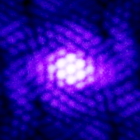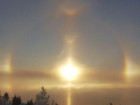|
Science and Astronomy Questions
|
|
| steeljaw354 | Date: Saturday, 13.08.2016, 23:14 | Message # 721 |
 World Builder
Group: Users
 Pirate
Pirate
Messages: 862
Status: Offline
| There probably are solar systems that don't have edge on orbits, right? Maybe a very influential discovery is among those...
|
| |
| |
| JackDole | Date: Saturday, 13.08.2016, 23:16 | Message # 722 |
 Star Engineer
Group: Local Moderators
 Germany
Germany
Messages: 1742
Status: Offline
| Quote Watsisname (  ) then this gives 2.3x1030J
And how much is that, calculated in Hiroshima bombs?
Don't forget to look here.

|
| |
| |
| Watsisname | Date: Saturday, 13.08.2016, 23:26 | Message # 723 |
 Galaxy Architect
Group: Global Moderators
 United States
United States
Messages: 2613
Status: Offline
| For non-transiting planets discovered by radial velocity technique, absolutely. There are bound to be some where the true mass is much higher than the reported figure.
However, the geometry works out such that the majority of planets have true masses that are fairly close to the minimum we measure as Msin(i). This is a nice consequence of the distribution of orbits (most probable viewing inclination is 45°) with the sine function (sin(45°)=0.707).

|
| |
| |
| steeljaw354 | Date: Saturday, 13.08.2016, 23:27 | Message # 724 |
 World Builder
Group: Users
 Pirate
Pirate
Messages: 862
Status: Offline
| How will we find exomoons? Why haven't we found any?
|
| |
| |
| Watsisname | Date: Saturday, 13.08.2016, 23:36 | Message # 725 |
 Galaxy Architect
Group: Global Moderators
 United States
United States
Messages: 2613
Status: Offline
| Quote JackDole (  ) And how much is that, calculated in Hiroshima bombs?
Wikipedia says that the Little Boy was 63TJ, so this would be about 3.7x1016 of those.
However, I don't think it's a useful comparison. I have some concept of how much energy one of those bombs gives off, but I have no concept of what 1016 of them would be like. We could try others:
-It's about 4.6 million times the energy of the Dinosaur-killer impact. Better, but still can't really fathom that number. All I know is it's a lot.
-It's about 1% of the gravitational binding energy of the Earth. Now that's meaningful. It tells us right away that this would definitely obliterate the planet, but isn't quite enough to disrupt it completely. The remains would be gravitationally bound and perhaps eventually coalesce again.
Quote steeljaw354 (  ) How will we find exomoons? Why haven't we found any?
There are a variety of methods that could work, from direct imaging to transit timing variations. But it is very hard. The sensitivity of the measurements must be very high, and is right on the limit of what we're able to achieve.

|
| |
| |
| steeljaw354 | Date: Sunday, 14.08.2016, 00:24 | Message # 726 |
 World Builder
Group: Users
 Pirate
Pirate
Messages: 862
Status: Offline
| What if we discovered a brown dwarf orbiting our sun? What effect would it have on humanity?
|
| |
| |
| Watsisname | Date: Sunday, 14.08.2016, 03:14 | Message # 727 |
 Galaxy Architect
Group: Global Moderators
 United States
United States
Messages: 2613
Status: Offline
| Hmmm. I'm tempted to think "about none", unless there are planets around the brown dwarf. I just can't think of how it'd be important for us except maybe in the really long term as a potential fuel source or something of that sort. What do you think?
Or how about instead of a brown dwarf, it's a black hole? Or a captured rogue planet?

|
| |
| |
| spacer | Date: Sunday, 14.08.2016, 03:20 | Message # 728 |
 Star Engineer
Group: Users
 Israel
Israel
Messages: 1258
Status: Offline
| Quote Watsisname (  ) Or a captured rogue planet?
what if planet 9 is a captured rogue planet? 
"we began as wanderers, and we are wanderers still"
-carl sagan
-space engine photographer
|
| |
| |
| midtskogen | Date: Sunday, 14.08.2016, 07:20 | Message # 729 |
 Star Engineer
Group: Users
 Norway
Norway
Messages: 1674
Status: Offline
| Quote Watsisname (  ) But I could also imagine, maybe, that dark matter is not particles at all. Maybe it's a fluid, or a scalar field, or something really weird and unlike anything we've seen before. I don't know how to describe how those would work in any great detail, but such models do exist.
One can likely produce many names trying to describe what is seen, but what causes it could remain obscure for a long time. Given the possibility to find explanations through speculations about the nature of extra dimensions, it seems to me that there is a great freedom of selecting models, all difficult to confirm by experiments. And who knows, perhaps when general relativity and quantum field theory are unified, dark matter is immediately understood, or vice versa.
NIL DIFFICILE VOLENTI

|
| |
| |
| FastFourierTransform | Date: Sunday, 14.08.2016, 10:24 | Message # 730 |
 Pioneer
Group: Local Moderators
 Spain
Spain
Messages: 542
Status: Offline
| Quote steeljaw354 (  ) Where did they come up with these methods to measure the density?
Quote steeljaw354 (  ) How will we find exomoons? Why haven't we found any?
Here you have much more information: http://phys.org/search/?search=exomoon&sort=0&period=all&refine=1
Quote steeljaw354 (  ) What if we discovered a brown dwarf orbiting our sun? What effect would it have on humanity?
Well, there was a scientific hypothesis about such scenario been ocurring right now (so, not much impact as you can see by the fact we have considered this seriously). The idea was that a brown dwarf called Nemesis (you can read on wikipedia about it) orbits the sun at a distance of 1.5 ly away causing periodic mass extintions on Earth (because his gravity would slingshot comets to the inner Solar System from the Oort cloud). The idea is currently rejected.
A related question would be: what effects could have a close encounter with a brown dwarf?
In fact we have been as close as 0.8 light years from a binary system (a cool brown dwarf plus a red dwarf in this case), called Scholz's star, 70.000 years ago (at this time, Homo Sapiens was migrating from Africa to Asia and was interbreeding for the fisrt time with the Neanderthals). Take a look to this paper where they discuss several aspects including the effects on Earth that this may have had.
Looking to the future we know that a star with 60% the mass of the sun (quite alarming), called Gliese 710, is going to make a 1.1 light year close aproach to the solar system in 1.360.000 years from now. You have the details of the encounter and perturbational effects that will have on the Solar System in this wikipedia article. But if you want more info here you have a paper that says there's even a 0,01% chance to perturb the Kuiper belt (that is very close to home).
By the way. Stars come close to the Solar System with a high frequency in terms of geological time-scales. Here you have a diagram of the nearest stars from 20.000 years ago to 70.000 years in the future (notice that Gliese's 710 encounter is way farther in the future and Scholz's is way back in the past, but you can see in the diagram how fast things move and change in the vicinity of the Solar System):

3.8 Myr ago we had even a close encounter of perhaps even just 1.14 light years of distance (90% confidence that the distance of the closest aproach was between 1.14 ly and 4.4 ly) with Gamma Microscopii, a yellow giant star of 2.5 solar masses. That was at the time our Austrolopithecus afarensis ancestors printed this footprints in a walk over wet volcanic ash in Tanzania:

Some of the effects on the Solar System are discussed in this excellent paper. It's amazing that in the upper distance estimate for the aproach (4.4 ly) the apparent magnitude of the star had been at least of -3.9 (as bright as Venus), and in the lower estimate of that 90% range of confidence (1.14 ly) the apparent magnitude had been -6.8 (6 times brighter than the peak luminosity of the Crab supernova recorded by the chinesse in 1054, or 10 times as bright as the ISS in the perigee of it's orbit, in full sun illumination and crossing the cenit). So the astrolopithecus afarensis may have been watching that yellow giant in the skies for quite a while! In this same paper the discuss the posibility that HIP 85605 could get to about 0.13 to 0.65 light-years from Earth in the next 470.000 years (that is considering the current uncertain values for distance and motion). More about stellar encounters will come with the Gaia mission results and measures.
It has been estimated that the strongest perturbations in the history of the solar system could have come from stars with 0.1 solar masses (brown dwarfs) in a range of close encounter distances from 741 AU to 1320 AU. Read this paper for more info about this.
_________________________________________________________________________________________
steeljaw354, I don't want to be rude in any manner but my english can make things sound strange so please interpret what I'm going to say; I admire your curiosity and will to inform yourself, but as a tip I think that you are asking many different questions that are easily solvable on a simple google search. For example, the exomoons question could have been ansewered with clarity and detail if you simply searched "exomoon" on google (the first page is from wikipedia and explains the methods used). If you put your exact same words ("brown dwarf orbiting our sun") from your last question on google you would find that the first page is a wikipedia article about Nemesis and the next webs are quite explicit answers. In that way you would find very interesting information much more quickly and deeply explained if you want to know. I know that Whatsisname is a great source, always willing to answer our questions, but we have to be more patient and let this thread to be less saturated.
With all of this I totally don't mean Don't ask questions (It would be a crime to ask you for that when you show such curiosity), but rather I want you to participate in a more enriching way; contributing to your own answers doing a bit of research before you ask and letting us know what you have find (it would be interesting for sure) insteed of aking many small different things in a row. It's okay if you do so, don't missunderstand me, but not always please, mainly because asking for chewed answers it's a lazy way to learn (and less satisfaying believe me). Also continue asking what you want, this is just a suggestion.
Edited by FastFourierTransform - Sunday, 14.08.2016, 10:33 |
| |
| |
| Watsisname | Date: Sunday, 14.08.2016, 11:12 | Message # 731 |
 Galaxy Architect
Group: Global Moderators
 United States
United States
Messages: 2613
Status: Offline
| I realize I'm often too eager with answering questions, and I love it when others put in a nice reply. Especially one as thorough and well documented as yours, FFT. Great post! 

|
| |
| |
| midtskogen | Date: Sunday, 14.08.2016, 11:25 | Message # 732 |
 Star Engineer
Group: Users
 Norway
Norway
Messages: 1674
Status: Offline
| These questions also happen to be among the more fascinating ones: How is it possible to weigh and measure stars and planets? It might sound impossible, but it turns out to be very simple if you can get the right observations.
NIL DIFFICILE VOLENTI

|
| |
| |
| FastFourierTransform | Date: Sunday, 14.08.2016, 12:21 | Message # 733 |
 Pioneer
Group: Local Moderators
 Spain
Spain
Messages: 542
Status: Offline
| Quote Watsisname (  ) FFT. Great post!
Thank you Watsisname 
This is a beautifull topic
|
| |
| |
| steeljaw354 | Date: Sunday, 14.08.2016, 16:30 | Message # 734 |
 World Builder
Group: Users
 Pirate
Pirate
Messages: 862
Status: Offline
| What if we discovered a mars mass object in the kuiper belt that we somehow missed, would it be a dwarf planet? If it is than that means they would have to re work the current definition. It makes 0 sense to demote a mars mass object.
Edited by steeljaw354 - Sunday, 14.08.2016, 16:32 |
| |
| |
| anonymousgamer | Date: Sunday, 14.08.2016, 16:49 | Message # 735 |
 World Builder
Group: Global Moderators
 United States
United States
Messages: 1011
Status: Offline
| I would think the real question is, what would happen to the Kuiper belt if there was a Mars mass object orbiting in it?
Desktop: FX-8350 4.0 GHz, 8 GB DDR3 RAM, EVGA GeForce GTX 1080 FTW 8 GB, 2 TB HDD, 24 inch 1920x1080 screen
Laptop: Core i5 480M 2.66 GHz (turbo 2.93), 8 GB DDR3 RAM, AMD Radeon HD 6550m 1 GB, 640 GB HDD, 17.3 inch 1600x900 screen
|
| |
| |